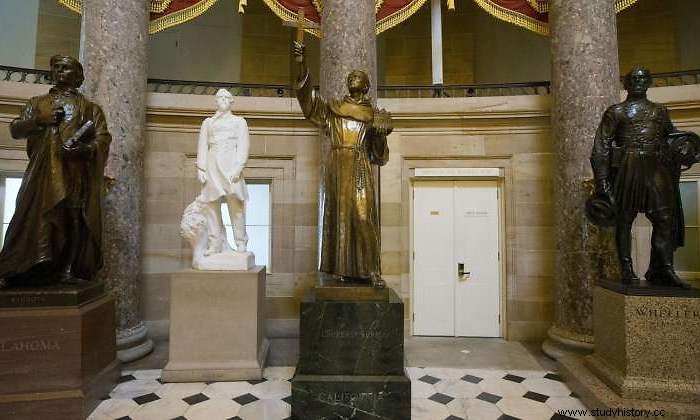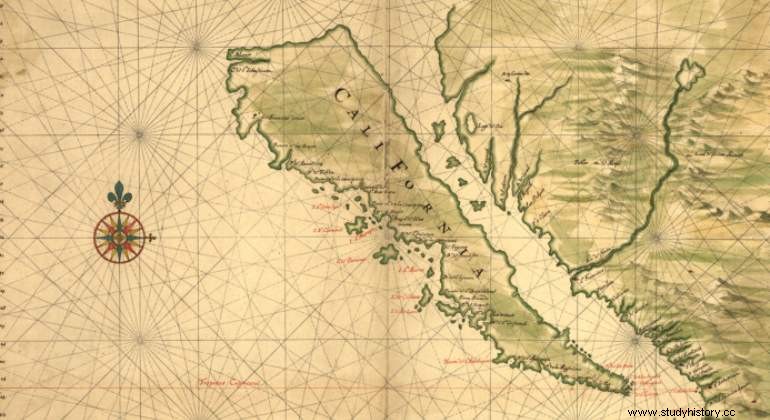About half a thousand protesters entered San Francisco's Golden Gate Park on the 19th to practice the new fashion of toppling statues. One of those chosen was the bronze effigy of Fr. Junípero Serra . This Spanish Franciscan, far from being a genocide or a racist, represented the opposite throughout his life, caring for and teaching the Indians, as well as the foundation of the missions that gave rise to many cities in California. . And already put, they must have thought that Cervantes needed a tuning. Unequivocal proof of the ignorance of these activists, of their ignorance of history and of how easily a noble cause can be contaminated and distorted. Although I know that these madmen are not going to read this article or change their minds, because the fanatics are faithful to their lies, I am going to tell them who Junípero Serra was. .
Crowd beat up on the statue after and tagged it, plus a nearby statue of Cervantes for good measure pic.twitter.com/F7foXW1ez6
— Joe Rivano Barros (@jrivanob) June 20, 2020
In the United States Capitol in Washington, D.C., is the National Statuary Hall, a two-story semicircular room that between 1807 and 1857 was the meeting place of the House of Representatives. Later it became the exhibition space for the collection of statues donated by the different states to honor outstanding people in their histories. It currently has 100 statues donated by 50 states, two for each, and among those representing California, for now, is that of Fray Junípero Serra, a native of Petra (Mallorca).

And I say for now because, although the proposal was later withdrawn, three years ago the idea of changing the statue of the Spaniard to that of astronaut Sally Ride, the first American woman to travel to space aboard the space shuttle Challenger in 1983. A change that did occur with the other statue that represented California since 1931, that of the preacher Thomas Starr King, which was changed for that of former President Ronald Reagan in 2009.
What does the Spanish Franciscan paint there? Well, simply because he is considered the founding father of California and I would like to add that he is also one of his excellent wines.
In their evangelizing adventure, the Jesuits spread throughout the American continent building missions. Logically, for the celebration of the Eucharist they needed to have wine, a precious and scarce good that had to be imported from Spain. So the missionaries decided that a solution that would ensure the wine supply was to plant vines (vitis vinifera ) around the missions and produce liturgical wine themselves without depending on the metropolis. In this way, the Jesuits first and, after their expulsion from all the domains of the Spanish crown by the Pragmatic Sanction (1767), the Franciscans later, became winegrowers.
After assuming the Franciscans, with Fr. Junípero Serra At the forefront, the role that the Jesuits had until now, in 1767 they left Mexico accompanied by their inseparable vines to the territory of Alta California, which today includes the states of California, Nevada, Arizona and Utah. And it is that although the Californian coasts had already been explored in the first half of the 16th century (Francisco de Ulloa, by order of Hernán Cortés in 1536, Juan Rodríguez Cabrillo in 1542 and the last one by Sebastián Vizcaíno in 1602) the interior remained almost ignored. two hundred more years. In fact, California was originally thought to be an island because the north was unexplored and it was not known to be a peninsula.
Thus, and after overcoming the great obstacle of crossing the inhospitable Sonoran desert, in 1769 the Mission of San Diego de Alcalá (today San Diego) was founded. And then, continuing north along the so-called Camino Real, the land route that linked the missions of Baja California (today the state of Mexico) with those of Alta California, the mission of San Francisco de Asís (today San Francisco). Along with these missions, in addition to evangelizing (make no mistake, it was their main task), the Franciscans created towns to house the Indians as they evangelized and in precisely chosen places a prison (from the Latin praesidium) was built. «protection», «garrison») which, despite what it may mean today, was a fortified post that housed the soldiers who protected the territory. In these towns, an attempt was made to integrate the Indians into that new society that, yes or yes, was going to engulf them, teaching them how to improve the yield of the land or the planting of new crops, providing them with the tools to work with iron and wood. or initiating them in new trades, such as bricklayer. Something that caused the Franciscans, and Junípero Serra especially, harsh confrontations with the civil power of the place.

In all the missions that were founded on this route, nine during the life of Fray Junípero (San Diego, San Carlos Borromeo, San Antonio de Padua, San Gabriel Arcángel, San Luis Obispo, San Francisco de Asís, San Juan de Capistrano, Santa Clara Assisi and San Buenaventura) vineyards were planted. So Friar Junípero Serra could be considered the father of California wines, which today is one of the most productive areas (if it were a country it would be the fourth largest producer in the world) and appreciated all over the world.
The variety that the Franciscans brought to the US from Mexico was called missionary grape . And although today there are hardly a few acres of this variety left in California, the viticultural vocation was impregnated in that territory.
And if the Franciscan was the founder of California and initiator of the wine activity in the territory, another Spaniard, Garci Rodríguez de Montalvo , was the toponymic father of him. But for that we have to go back a little further in time...

Garci Rodríguez de Montalvo, a writer from Medina del Campo (Valladolid), gained fame at the beginning of the XVI when he adapted and rewrote one of the best-known chivalric books of the Middle Ages, Amadis de Gaula , a reference for Cervantes when writing Don Quixote. He was so passionate about the subject that he added a fourth volume to it - the original work of Amadis consisted of three volumes - and even in 1510 he was encouraged to write another book as a continuation of the saga, Las sergas de Esplandián .
If to the popularity of Garci Rodríguez's novel when the Spaniards explored the Californian coasts (even a century later it will continue to be so and Cervantes will cite it in Don Quixote among the works burned by the priest and the barber to rid the hidalgo of his addiction to these books) we add that a fantasy paradise island called California appears in it, and that, as I said before, said territory was thought to be an island, we have the origin of the name of this state.
By the way, the work Las sergas de Esplandián , which could be translated as The exploits of Esplandián , you have an error in your title. Garci Rodríguez, whose Greek left a bit to be desired, wanted to credit the Greek origin of his character Esplandián de él to give him an epic touch and mistakenly used the word sergas , which does not exist, instead of ergas , which in Greek means exploits.
